A History of HMS RANEE
|
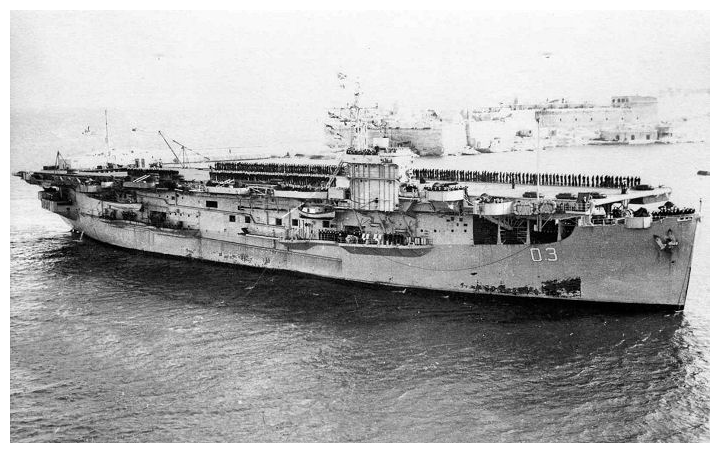 |
HMS RANEE entering Valletta harbour on one of her
trooping voyages in 1946. |
HMS
RANEE was an 'Ameer' class escort carrier, her keel was laid
down on January 5th 1943, at Seattle-Tacoma Shipbuilding Co. Tacoma,
Washington, a C3-S-A1 type freighter Maritime Commission hull number
257, Seattle-Tacoma hull number 41. The hull was purchased by the US
navy to become the auxiliary aircraft carrier USS NIANTIC
AVG-46, a 'Prince William' class escort carrier.
Whilst
still under construction it had been decided that AVG-46 was to be
transferred to the Admiralty on loan on her completion as an
aircraft carrier. AVG-46 was launched on June 2nd 1943 by her
sponsor Mrs. Ray V. Blanco. On July 15th 1943 her US Navy
designation was changed to CVE-46.
CVE-46
was delivered to the US Navy on November 8th 1943 and was
transferred to the United Kingdom under the lend-lease scheme the
same day, and commissioned into RN service as HMS RANEE
(D03), Captain J.S. Metcalf RN in command.
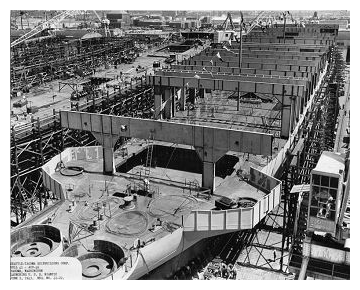 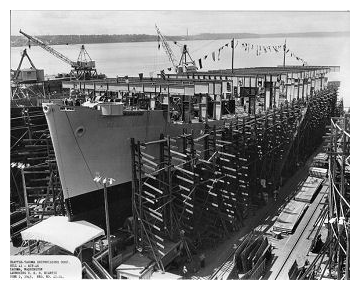 |
The completed hull of the USS 'NIANTIC' AVG-46 at the
Seattle-Tacoma Shipyard, Tacoma, Washington ready to be
launched. Photo: Ronny Jaques / National Film Board
of Canada. Photothèque / Library and Archives Canada |
Move to Vancouver and work up period: November 1943 - January
1944
On
completion of defect rectification following her builder's sea
trials RANEE sailed for Vancouver Island, British Colombia,
arriving there on November 19th. She was one of 19 escort carriers
sent there to be modified to meet Admiralty requirements by the
Burrard Dry Dock Co. Ltd., North Vancouver, British Columbia.
However it had been decided by the Admiralty that in order to address a
shortage in aircraft deliveries to India, the CVEs RANEE and
PATROLLER
were not to enter Burrard's yard for the full modification work.
Instead, the two carriers were to receive the minimum alterations
required to bring them to operational status for ferrying purposes.
A reduced crew joined RANEE at Vancouver, her air department
was to comprise of only an Air Engineering officer and 10 ratings -
all that was required for the ferry role. The remainder of her air
department, flight deck crews etc would be drafted in when she was
to begin flight operations.
RANEE was to spend the next two months at Vancouver completing a
work-up, storing the ship, and familiarising the crew in preparation
for ferry duties. On January 26th 1944 while operating in the
Georgia Strait, between Vancouver Island and the Pacific coast of
British Columbia, RANEE was called upon to offer assistance
to her sister CVE HMS NABOB. She was taking advantage of the
aircraft of 850 squadron based at RCAF Sea Island, and had arranged
a day of flight operations to put the ship through its paces. While
steaming at speed into wind to receive aircraft NABOB had run
aground on an uncharted sand bar and stuck fast. RANEE stood by in
case a tow could be rigged in an attempt to pull her off. Two
attempts were made to pull NABOB free, the first at high water in
the forenoon with RANEE secured astern, HMCS ARMENTIERES
on the starboard and HMCS HARO on the port side; the
operation was a failure. A second attempt was made at 18:10 when the
tide was again high. NABOB's crew had worked hard to lighten
the ship by pumping out three hundred tons of oil and seven hundred
tons of salt water from the petrol tanks. The three ships strained
on their towing hawsers while NABOB's engines ran at full
astern and heaved in on her bow anchor; again the attempt failed.
RANEE sipped the towing line and returned to Vancouver as two
salvage tugs were on route to the scene; it was to take another
three days to re-float NABOB.
Maiden Voyage: Aircraft ferry voyage to India: February - may
1944
On
completion of her work-up, HMS RANEE was temporarily
allocated to the Eastern Fleet as an aircraft transport for
operations in the Pacific and sailed for San Francisco on February
4th 1944. Her mission appears to have been two-fold. Firstly to
deliver a consignment of sixty aircraft to RNAMY Cochin in Southern
India, and secondly to collect and return to Fremantle a dozen
American War Brides who had married Australians, together with other
service passengers taking passage to Australia and India. RANEE
Arrived in Wellington, New Zealand on February 25th and made an
overnight stop before sailing for Fremantle in Western Australia,
arriving there on Match 8th. After disembarking her passengers
RANEE proceeded to Cochin, arriving there on March 18th and
began unloading her cargo of aircraft. RANEE sailed for the
return leg of her voyage to Vancouver on March 31st calling at Port
Phillip. Melbourne, Australia, to refuel and put ashore a member of
the crew had been taken ill and required hospital treatment.
Modification period at Vancouver: May - August 1944
HMS
RANEE arrived back in Vancouver May 8th 1944 and was berthed
at Ballantyne Pier, Vancouver, to await her turn to enter the
Burrad's yard. She was moved to No. 8 berth, Lapointe Pier, on May
14th for work to begin. While in Vancouver, Captain Metcalf left the
ship, Captain A.A. Murray RN arrived to assume command.
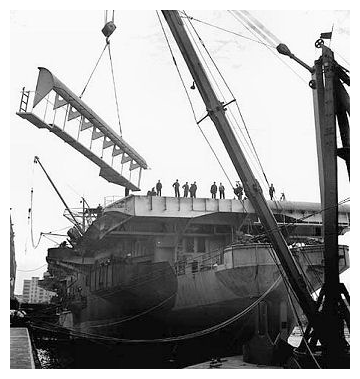 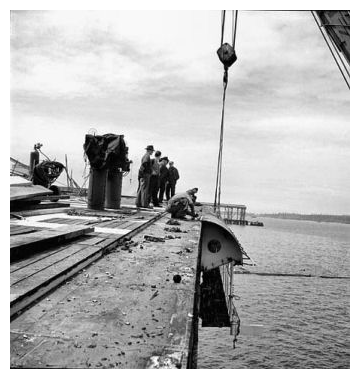 |
HMS RANEE has her round-down removed ready for the
lengthening of her flight deck in Burrards dockyard,
Vancouver. Photo: Ronny Jaques / National Film Board
of Canada. Photothèque / Library and Archives Canada |
As
work progressed the ship was moved to No. 7 berth on March 19th, to
berth No 3 on May 23rd and berth No 4 on June 9th. On June 22nd
Ranee sailed to Esquimalt and entered dry-dock the following day for
the fitting of sea cocks and remedial work; the work took 4 days to
complete, the ship undocking on the 27th. On her return from
Esquimalt, Ranee returned to berth No 4 to continue her
modifications. The ship was to make one last move to berth No 5 on
June 30th to complete her modifications and to store ship. The
alteration and modification phase of the work was completed by July
12th, having taken a total of 59 days. Part of this work included
the addition of 278 tons of pig iron as additional ballast.
[Note: the last five CVEs to pass through Burrard's dockyard,
PATROLLER, PUNCHER, REAPER, RANEE and THANE had a longer
modification timetable than the other 14 vessels modified by
Burrard's. This was due to the Admiralty decision that the single
Oerlikon mounts on the Gallery Deck and foc'sle deck, were to be
changed for fourteen twin mountings. An extra ten days was allocated
for this work to be completed.]
On
July 13th RANEE left Vancouver for Esquimalt and re-entered
dry-dock on the 14th to complete the fitting of ASDIC equipment; on
undocking on the 15th. Prior to her sailing from Esquimalt, RANEE
received her first aircraft - a non-airworthy RCAF Blackburn Shark
given to the RN on free issue for training flight deck handing
parties on the voyage to Norfolk, Virginia. The Shark was ferried
out to the ship by lighter from No. 3 Repair Depot RCAF where her
floats had been substituted for wheels. Four other CVEs at
Vancouver, PATROLLER, PUNCHER, REAPER, and THANE also
received written-off Sharks for this purpose. These vintage aircraft
caused some interest when the five ships put into US ports; the
aircraft were finally pushed overboard when their usefulness had
come to an end and deck cargo was due to be loaded.
Second Ferry Voyage: Norfolk to Cape Town, September 1944
RANEE
sailed for Norfolk, Virginia, via San Francisco and the Panama Canal
to begin her second ferry voyage. On her arrival at the US Navy
Operating Base, Norfolk, RANEE began embarking a ferry load
of sixty Grumman Hellcats for delivery to RNARY Wingfield at Cape
Town, South Africa. She sailed from Norfolk on September 5th, and
arrived in Cape Town on the 23rd. After unloading her cargo Ranee
returned to Norfolk in October to collect a third ferry load, this
time bound for the UK.
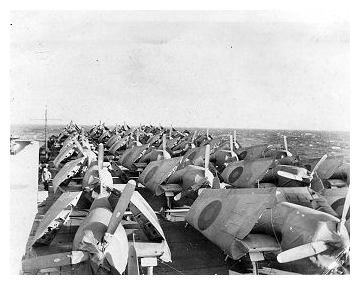 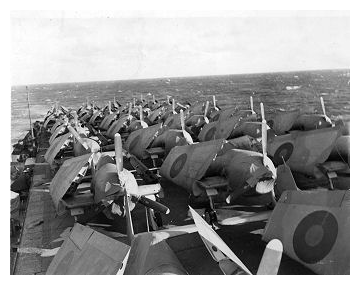 |
HMS RANEE on route to South Africa ferrying 60 Hellcats |
Third Ferry Voyage:
Norfolk to Greenock, October 1944
This
load included the aircraft and squadron personnel of number 1846 (18
Corsair) & 1848 (18 Corsair) Naval Air Squadrons for passage to the
UK, their aircraft were ranged on the flight deck while the hanger
deck was filled with spare lend-lease airframes. On October 18th
1944 RANEE was allocated to Western Approaches Command as a
ferry carrier and sailed for New York. On the 22nd she sailed with
Convoy CU 44 which arrived at Liverpool on November 2nd, RANEE
left the convoy off Ireland and proceeded to Belfast where she
unloaded the airframes and personnel of 1846 and 1848 squadrons to
RANMY Belfast before continuing on to Greenock.
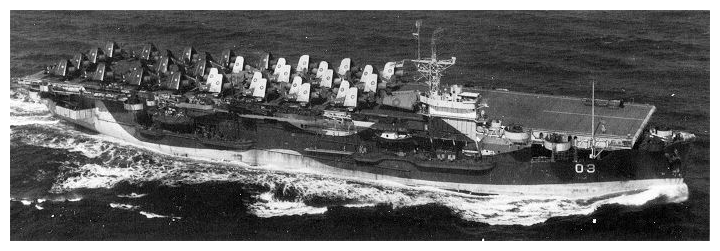 |
HMS RANEE employed on ferry duties October 1944. |
Deck Landing Training Duties: November
1944 - January 1945
While
at Greenock the crew were granted five days leave to each watch
before the ship set sail for the Firth of Forth. There she was to
relieve HMS SPEAKER from November 23rd as the duty Deck
Landing Training Carrier, operating from Rosyth and Methil for the
next six weeks. Before beginning this duty RANEE was put
through her first flying trials when an Avenger, a Hellcat and a
Wildcat from 778 Service Trials Unit at RNAS Arbroath were safely
landed on and flown off on the 23rd and 24th of November. During her
period as a training carrier RANEE operated a variety of
aircraft types, mainly from 768 Deck Landing Training squadron based
at RNAS Arbroath, and others from squadrons working up in Scotland.
Out of approximately 2,000 landings and take offs there were 17
crashes; the most serious incident occurred on December 15th when
Sub Lt F. Sumner of 766 squadron was killed. He was making his first
night carrier landings in Swordfish NF315, when he bounced on
landing and flew over the barriers, the aircraft touched down on the
forward end of the Flight deck and ran over the bows into the sea
and sank.
HMS
RANEE entered Rosyth Dockyard for a short refit commencing on
December 27th. On New Year's Day 1945, RANEE put to sea for a
further week of carrier training but suffered a mechanical breakdown
while still in the Firth of Forth which caused the ship to go
completely out of control just as she had achieved a speed of some 6
or 7 knots. Not under power and not responding to helm control she
was in danger of colliding with other merchant shipping moored in
the area; she avoided the first ship in her path only to end up on
course straight for HMS DEER SOUND. In an attempt to stop the
ship, the port anchor was let go, she was no longer under power and
so had lost most of her forward momentum; in the end RANEE
made light contact with the side of DEER SOUND which left a
small dent in her bows but no other damage. After making repairs
RANEE resumed her duty as the Deck Landing Training Carrier on
January 4th.
Loaned to the U.S. Pacific Fleet: January - May 1945
On
completion of her tour as the deck landing training carrier RANEE
proceeded to Greenock for boiler cleaning, in preparation for loan
to the U.S. Carrier Transport Squadron, part of the U.S. Pacific
Fleet. On arrival in Greenock five days leave was granted to each
watch and command of the ship passed to Captain J.A.W. Tothill DSC,
RN who relived Captain Murray on January 20th.
HMS
RANEE sailed on Sunday January 21st to join the New York
bound Convoy UC 53B; the crossing was heavy going as Atlantic gales
lashed the ships for most of the voyage. RANEE suffered
damage to her flight deck and in her hanger when the ship's Jeeps
tore loose from their lashings and careered around smashing into
things. On January 30th, about 300 miles short of New York, RANEE
rendezvoused with the American destroyer USS CECIL J. DOYLE.
She was to act as her guard ship for passage to Cristobal, through
the Panama Canal and north to San Diego. On leaving the convoy
RANEE came beam on to the storm and rolled violently for nearly
24 hours until she reached the calmer waters of the Caribbean. It
was rumoured that at its height, the roll was 28 degrees from the
vertical. RANEE reached Cristobal 17 days out from Greenock
and after clearing the Panama Canal the ship preceded to San Diego,
California.
The
first order of business was voyage repairs, once these were
completed RANEE began to embark the aircraft for delivery the
forward pacific areas. RANEE left San Diego on February 21st
1945, escorted on the first leg to Pearl Harbour by the USS HUGH
W. HADLEY, arriving at Pearl Arbour on February 27th. RANEE
continued on to Guam in company with the USS EDWARD C. DALY.
The personnel of USN Air Group 80 embarked in HMS
RANEE at Guam on March 19th for transportation back to Pearl
Harbour, arriving there on the 24th.
RANEE was to make a second round trip from Pearl Harbour,
Eniwetok and Guam, ferrying U.S. naval aircraft and personnel before
receiving orders in mid-April that she was to return to the UK.
Forth Ferry Load: Norfolk to Greenock, May 1945
On
arrival back in San Diego RANEE returned to RN control and
spent a week having a boiler clean before she sailed on May 2nd for
the US Naval operating base at Norfolk to embark a ferry load. She
next sailed for New York arriving there on the 23rd to embark
passengers - officers, women and children and a few schoolboys
returning home. Ranee sailed as part of convoy CU 72, one of the
last New York to UK convoys of the war, departing New York on May
25th and arriving at Glasgow o June 4th 1945.
Modification and conversion for duty as a replenishment carrier:
May - August 1945
On
arrival at her mooring at Tail of the Bank on the Clyde work, began
to convert RANEE to a Replenishment Carrier for duty with the
British Pacific Fleet. This primarily entailed the 'tropicalisation'
of the ship's ventilation system and the addition of extraction fans
in key areas. Dockyard workers were ferried out to the ship each day
to work on her until the announcement of the Japanese surrender and
the end of the war. RANEE's conversion work was halted when
the Admiralty reallocated her as one of six RN CVEs (along with
ATHELING, RAJAH, QUEEN, PATROLLER and FENCER) selected
for conversion for Naval Trooping, these ships were to be employed
bringing military personnel from the Far East back to the UK and
some commonwealth countries.
Conversion for Trooping Duties: September - November 1945
On
September 12th, RANEE sailed for Barrow-in-Furness to receive
her trooping conversion; the work being carried by a Tyneside
shipyard. As part of her conversion she was to have increased
accommodation and facilities to house 1000 personnel in addition to
her own crew. Three tier bunks and associated kit lockers for 564
men were installed in the hanger to supplement the existing
accommodation available for 786 men, 700 in mess decks and 86 in
hammocks. Additional washing and toilet facilities were built in the
after lift well, and now unoccupied aviation workshop spaces. Extra
galley equipment was added to augment the American cafeteria style
messing and dining areas for sittings of 240 men were set up in the
hanger. Time was of the essence in this work, also costs. Minimal
remedial work was authorised for the six ships, the conversion work
taking priority. RANEE's conversion was shorter than those of
the other five CVEs. Her 'tropicalisation' had been completed before
she arrived on the Tyne and she was ready to proceed to Portsmouth
Dockyard on November 8th 1945 to complete a final storing before
sailing on her first trooping voyage.
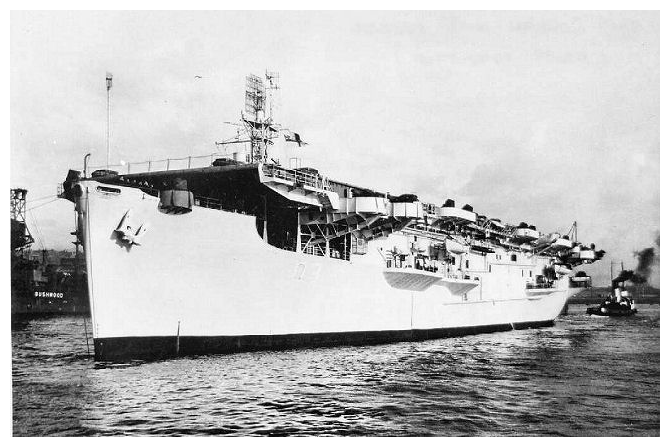 |
HMS RANEE emerges after her conversion into a troop ship
in November 1945. |
Trooping operations: December 1945 - Novembe4h4h446
RANEE
was to sail for Ceylon at the beginning of December carrying a draft
of naval personnel for the East Indies Fleet, leaving Portsmouth on
the 5th bound for Port Said to transit the Suez Canal. RANEE
arrived at Colombo on December 27th and disembarked passengers.
After loading stores and passengers for onward passage RANEE
sailed for Sydney on the 29th, from Sydney she made for Fremantle
and back to Colombo before arriving in the UK at Davenport Dockyard,
Plymouth on February 215th. Once her passengers had disembarked
RANEE proceeded to Portsmouth Dockyard, arriving there on the
27th, to undergo voyage repairs; this work took a month to complete
and included entering dry dock.
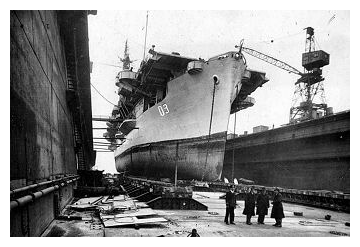 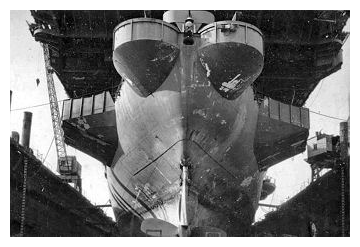 |
HMS RANEE in dry dock at Portsmouth undergoing voyage
repairs, from 27 February to 27 March 1946. Photo:
Desmond Field |
On
completion of repairs RANEE sailed to repeat her round trip
trooping voyage to the Far East leaving Portsmouth on March 27th
1946. She was to make at least three trooping voyages before
returning home to the UK to be de-stored and have RN equipment
removed in preparation for her return to the US Navy.
On her
final Atlantic crossing RANEE carried passengers which
included servicemen's families, stores and equipment for delivery to
the Royal Naval Dockyard at Bermuda before continuing on to Norfolk
Naval Base.
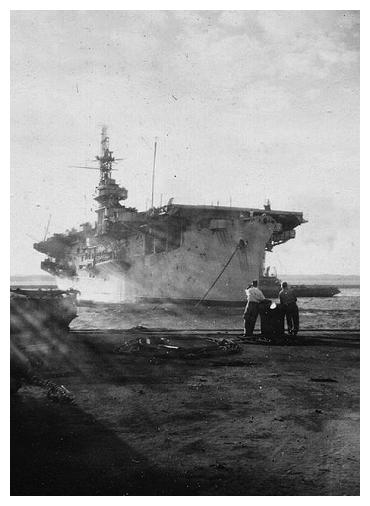 |
HMS RANEE at the Royal Naval Dockyard at Bermuda on her
final voyage as an RN ship. |
Disposal: Return to US Custody
CVE-46
was returned to US Navy custody on November 21st 1946 at Norfolk,
Virginia; she was stricken for disposal on January 22nd 1947 and was
sold on June 9th 1947 to the Waterman Steamship Corp., Mobile,
Alabama for merchant service. She was sold on to the Rotterdam Lloyd
line in 1948 and renamed SS FRIESLAND. Before being sold
again to Panama in 1967 and renamed SS PACIFIC BREEZE. She
was scrapped in Taiwan, beginning in May 1974.
|
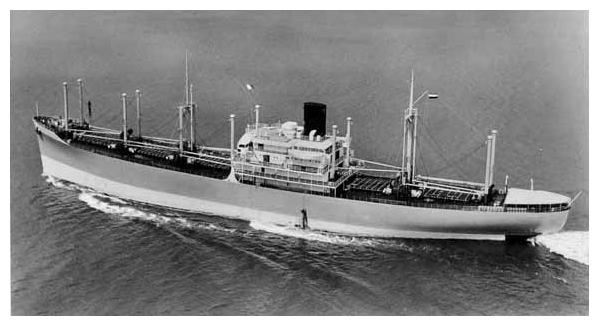 |
The S.S. FRIESLAND operated by the Rotterdam Lloyd line |
|
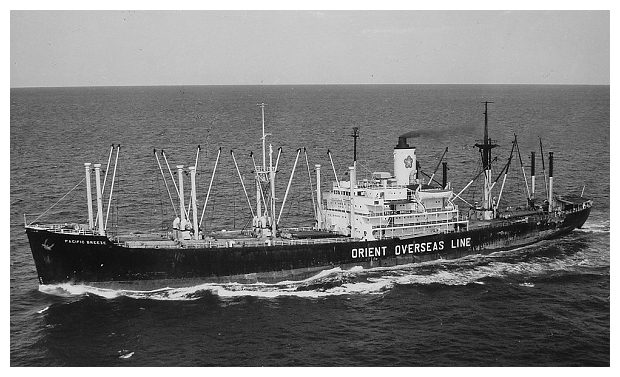 |
The the Panamanian-flagged SS PACIFIC BREEZE (owned by
C. Y. Tung, Hong Kong) in the Malacca Straits, date
unknown. Photo: Gerhard Mueller-Debus via
Navsource |
Content revised:
31 October 2021
Sources used in compiling this account:
Click here for a list of
Primary sources
Additional sources:
Anon, (1945) 'A brief History of HMS
RANEE' HMS RANEE
Writers Office
Fold3.com various documents including;
Admiralty War Diaries
Norfolk Navy Yard War Diaries
Mew York Navy Yard War Diaries
Miscellaneous documents
|
Home
page |
go to the top
|
Comments (0)